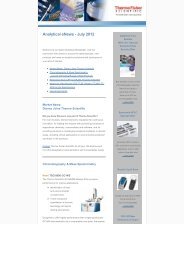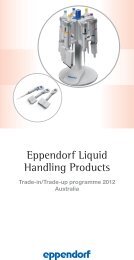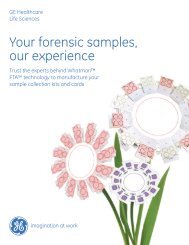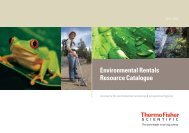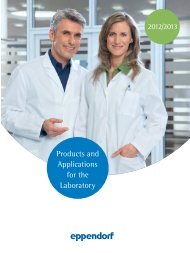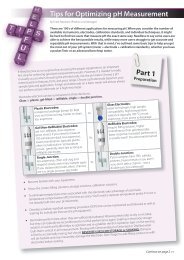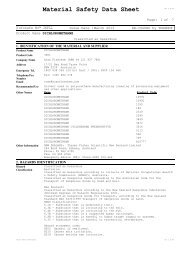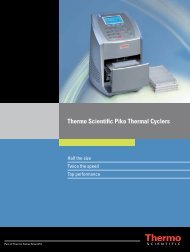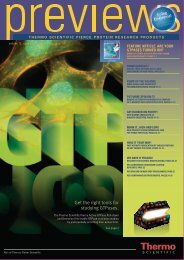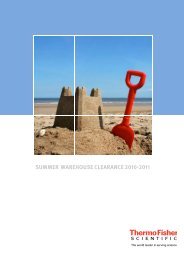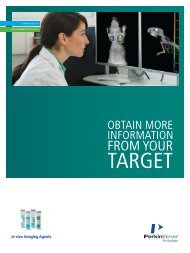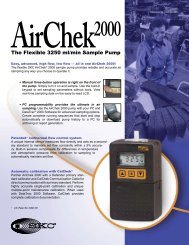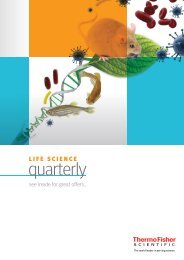Issue 1 - Thermo Fisher
Issue 1 - Thermo Fisher
Issue 1 - Thermo Fisher
You also want an ePaper? Increase the reach of your titles
YUMPU automatically turns print PDFs into web optimized ePapers that Google loves.
Application Note<br />
A Novel Feeder-Free Embryonic Stem Cell Culture System that<br />
Supports Mouse Embryonic Stem Cell Growth and Proliferation<br />
Kalle Johnson 1 , Robin Wesselschmidt 2 , Mark Wight1, Thomas I. Zarembinski 3<br />
Figure 1: Phase contrast<br />
photographs of mESC<br />
colonies over the course<br />
of the study. Photos<br />
of colonies grown on<br />
HyStem-C (top Row)<br />
and photos of colonies<br />
co-cultured with MEF<br />
feeders (bottom row).<br />
Morphologies bear<br />
slight differences<br />
between HyStem-C<br />
and MEF co-cultures.<br />
However, cultures grown<br />
on both substrates were<br />
able to maintain colonies<br />
that generally exhibited<br />
relatively regular, phasebright,<br />
well defined<br />
borders, characteristic of<br />
undifferentiated mESC<br />
colonies.<br />
HyStem<br />
iMEF<br />
Passage 1<br />
Passage 2 Passage 3 Passage 4 Passage 5<br />
1<br />
<strong>Thermo</strong> <strong>Fisher</strong> Scientific<br />
Inc., 925 West 1800<br />
South, Logan, Utah<br />
84321<br />
2<br />
Primogenix Inc., 165<br />
Missouri Blvd, Laurie,<br />
MO 65038<br />
3<br />
Glycosan BioSystems,<br />
Inc., 675 Arapeen Drive,<br />
Suite 302, Salt Lake City,<br />
Utah 84108<br />
References:<br />
1) Gerecht S et al,<br />
Hyaluronic acid hydrogel<br />
for controlled<br />
self-renewal<br />
and differentiation of<br />
human embryonic stem<br />
cells PNAS 2007 vol 104:<br />
11298–11303.<br />
2) Engler et al, Matrix<br />
Elasticity Directs<br />
Stem Cell Lineage<br />
Specification Cell 2006<br />
vol 126: 677-689.<br />
For more information<br />
please contact:<br />
Peter Chisholm (AU)<br />
peter.chisholm@<br />
thermofisher.com<br />
Ph: +61 3 9757 4457<br />
Jerry Wong (NZ)<br />
jerry.wong@<br />
thermofisher.com<br />
Ph: +64 9 980 6768<br />
Standard embryonic stem cell culture systems require<br />
co-culture with mitotically inactive mouse embryonic<br />
fibroblast feeder cells (iMEFs) to maintain their<br />
undifferentiated proliferative state.<br />
While iMEFs provide a suitable attachment surface<br />
and crucial soluble factors promoting embryonic stem<br />
cell (ESC) growth and proliferation, iMEFs are timeconsuming<br />
to prepare. More importantly, iMEFs vary<br />
from lot-to-lot and contaminate ESCs with carry over<br />
iMEFs from previous culture passages.<br />
These latter shortcomings confound basic research<br />
attempting to dissect the culture components or<br />
underlying gene and protein expression patterns<br />
important for ESC proliferation and differentiation.<br />
Development of a feeder-free system for embryonic<br />
stem cell culture using a synthetic matrix would provide a<br />
ready-to-use substrate which is consistent from lot to lot<br />
without iMEF carry over.<br />
iMEFs make abundant amounts of hyaluronic acid (HA)<br />
which is important for not only embryogenesis but<br />
also for human embryonic stem cell culture (1) . Using<br />
mouse embryonic stem cells (mESCs) as a model<br />
system, we reasoned that the use of a commercially<br />
available HA-rich matrix would provide a suitable starting<br />
point for preparing a novel feeder-free substrate for<br />
undifferentiated growth.<br />
Here we report the use of a crosslinkable HA-based<br />
substrate (HyStem-CTM) for feeder-free propagation<br />
of mESCs in the presence of FBS. mESCs plated on<br />
HyStem-C maintain excellent morphology and offer<br />
comparable plating efficiency to those grown on iMEFs.<br />
Data from FACS analysis as well as immunocytochemistry<br />
to confirm the presence of key recognised pluripotency<br />
markers will be presented. (Figure 1)<br />
This novel feeder-free cell culture system has potential<br />
uses in proteomic analysis since no carryover iMEF<br />
proteins will be present in embryonic stem cell extracts.<br />
In addition, statistics from high content analysis and<br />
high-throughput screening efforts employing mouse<br />
embryonic stem cells will be improved due to increased<br />
consistency during the screening campaign.<br />
Finally, the possibility exists to alter the stiffness or<br />
composition of the matrix in a manner that may enhance<br />
efforts to drive the pluripotent cells down desired<br />
lineages (2) .<br />
Three types available<br />
• HyStem Hydrogel - Chemically modified<br />
hyaluronan crosslinked with PEFDA<br />
• HyStem-C – HyStem with chemically<br />
modified gelatin added<br />
• HyStem-HP – HyStem-C with<br />
chemically modified heparin<br />
Hydrogels can be easily customised<br />
• by adding ECM proteins<br />
• by varying the Hydrogel compliance to match the<br />
stiffness of the native tissues<br />
• easy control over the amount and type of ECM protein<br />
incorporated<br />
• no autofluorescence<br />
• ideal for non-adherent cells – easy to mobilise<br />
• for adherent cells, simply add choice/selective cell<br />
attachment peptide<br />
• allows encapsulation and implantation of cells<br />
8



